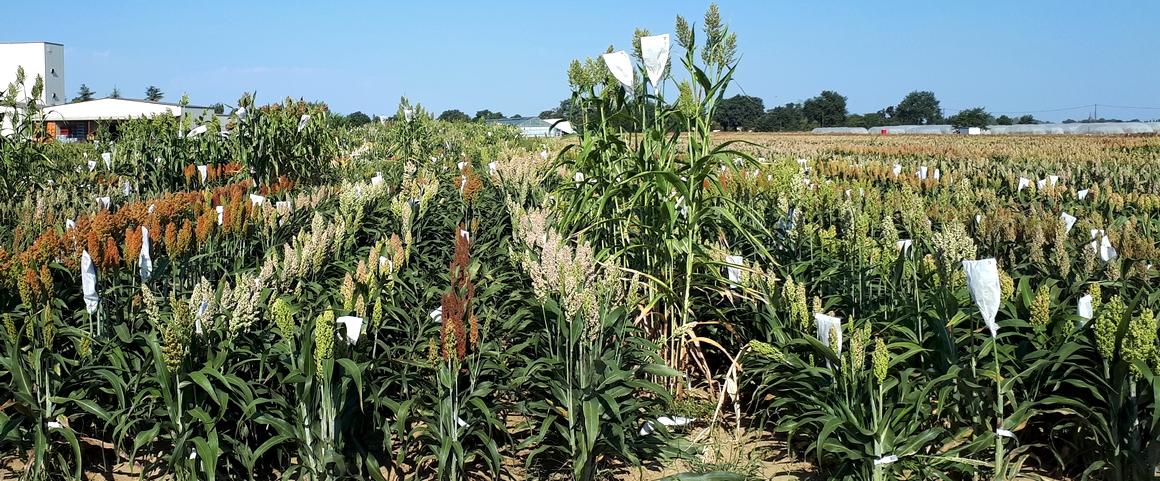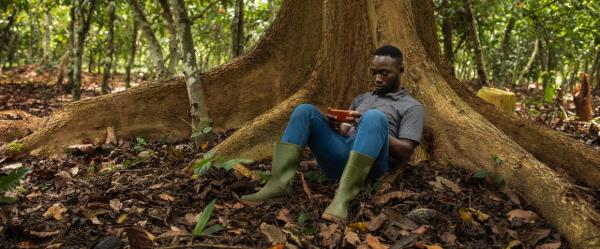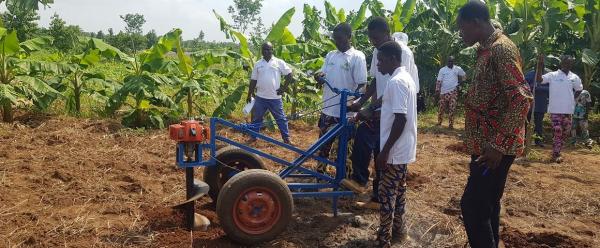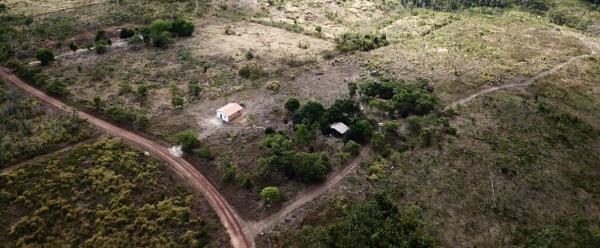Call to action 25 November 2025
- Home
- CIRAD news
- News
- sorghum: strengthening North-South cooperation
Objective sorghum: strengthening North-South cooperation

Dozens of sorghum varieties are currently being tested in the Occitanie region of France. Here, at the LIDEA station in Mondonville © D. Pot, CIRAD
Sorghum, a grain capable of resisting very dry climate episodes, is now emerging as a plant with some major benefits. Four years after the first Global Sorghum Conference, this second edition has been the opportunity to cover a broad spectrum of scientific and industrial knowledge and practices.
Jean-François Rami, a sorghum breeder at CIRAD, was one of the key organisers of the conference*: “These events are pivotal moments that take stock of progress and outline future areas of research. They are the opportunity for exchanges between disciplines, sectors and fields, providing complementary points of view. Basic research, applied research, economics, culture – all subjects are covered”.
Each country has its own resources and goals
In the global North, some countries focus on agricultural intensification through monoculture, the optimisation of chemical fertilisation or the use of plant protection products. Others, on the contrary, consider sorghum as a vector of climate change adaptation and are working to improve the resilience of their production systems.
In Europe, for example, more and more farmers are including sorghum in their crop rotations. This enables them not only to cope better with droughts and extreme temperatures, which are increasing in frequency, but also to respond to rapidly diversifying markets.
For many countries in the global South, sorghum is first and foremost a response to food security problems. This grain of African origin is a staple for more than 300 million people living in the rural semi-arid regions. In particular, sorghum is very common in the Sudano-Sahelian zone.
Although the contexts and the goals vary, the levers that contribute to the development of this crop in the different target areas are often similar. David Pot, a geneticist and sorghum sector correspondent at CIRAD, explains: “In both the North and the South, the challenges revolve around two major questions. First, climate change mitigation and adaptation issues, which are becoming increasingly urgent. The second focal area concerns the structuring of sorghum-based markets, whether for human food, animal feed or the development of non-food products. These two challenges are common, hence the need to accelerate exchanges between fields”.
Acting as an intermediary between partners in the South and the North
“At CIRAD, the African partners we work with have been studying sorghum for years. They have a wealth of long-established expertise on this crop, concerning varietal development, cropping system optimisation and food processing”, says David Pot. “As for our partners in the North, they are developing skills in genomics for use in plant breeding. This type of research often involves different disciplines, helping to take better account of processors’ or consumers’ needs in breeding programmes. In this context, one of CIRAD’s goals is to create synergies between these areas of expertise”.
The researcher insists on the scientific importance of the West African partners. By crossing elite local varieties with other varieties representing the global diversity of this grain, their research has identified sorghum populations that are extremely useful to the genetic understanding of the plant. This information is crucial for contexts in both the South and the North.
These analyses have also benefited from tools developed in collaboration between the North and the South. There are many examples of synergies in all of the disciplines mobilised in sorghum production and processing. David Pot continues: “Our goal at CIRAD is to ensure a win-win exchange. We try to make sure these results are obtained more and more rapidly and that they then effectively feed into the different production systems”.
In June, the participation of the African continent in the Sorghum Conference was supported by the organising consortium and the United States Agency for International Development (USAID). Some 80 African partners were able to present their research, accentuating the international dimension of the event. “In addition to the linkages between research institutes from the North and the South, we hope to contribute to increasing the involvement of producers, processors and consumers. To ensure our research findings are aligned with the expectations of societies, we need their engagement”, says Jean-François Rami.
Beyond plant breeding, diversifying crops
Compared with maize, wheat and rice, which are the world’s three main cereal crops, sorghum is lagging behind in terms of plant breeding. Its productivity and its advantages to contribute to the portfolio of solutions for climate change adaptation and mitigation in cropping systems can still be greatly improved through genetics and breeding efforts. Breeders from all countries are currently stepping up efforts to close this gap, as demonstrated by the prominence given to research on genetics and breeding at the global conference in June.
The European Union is financing the ABEE project, for example, which is aimed at modernising plant breeding programmes in several West African countries. The first crops to benefit from these efforts are sorghum, millet, fonio, cowpea and groundnut. CIRAD is contributing to this project by supporting scientific partners in Africa and is thus sharing its expertise on the optimisation of breeding programmes.
These new programmes are giving more and more importance to farmers, processors and consumers. Indeed, “while some varieties perform well on the agricultural level, they do not necessarily correspond to people's tastes, or simply to local methods of preparation”, says David Pot. “The goal is therefore to better integrate the expectations of producers, processors and consumers. We thus involve them ahead of the implementation of breeding programmes, but also throughout the whole varietal development process”.
The scientists do not stop there: over and above improvements at the plant level, CIRAD’s research also focuses on optimising cropping systems – intercropping with legumes, crop rotations, agroforestry, etc. In Africa, these agroecological practices based on biodiversity and soil health are already well established.
“These are ‘diversified cropping systems’. They are far more resilient to climate change, but need to be optimised in terms of production”. According to David Pot, integrating issues of plant breeding and cropping system optimisation is one of the future strategic focal areas for the sorghum sector at CIRAD “We have all the expertise needed to achieve this ambition. It will require stepping up exchanges between disciplines and fields, with our institutional partners and with civil society”.
* This second Global Sorghum Conference, held in Montpellier from 5 to 9 June 2023, was organised by CIRAD, in partnership with the Global Collaboration on Sorghum and Millet at Kansas State University, Sorghum ID, IRD and the Centre d’Etude pour l’Amélioration de l’Adaptation à la Sécheresse (CERAAS).



























